John Joseph Daly was born on the 6 February 1920, in Portlaw, County Waterford, Ireland.
In November 1939 he travelled to Northern Ireland to enlist in the British Army and joined The Royal Inniskilling Fusiliers.
On the 13 June 1941 he was on board the SS St Patrick, going home on leave. The ship was a British Passenger Steamer on its regular run from Fishguard to Rosslare, when it was attacked and bombed by German aircraft; broke in two and sank. 12 passengers, 17 of her crew and one gunner were killed. John Daly, one of the survivors, recalled that it had totally spoiled his only suit and his leave!
However it is apparent from a letter to him, and kept by his family, that he had performed an act of bravery.
Dear Jackie,
We, the members of your old Troop, feel we must drop a line, firstly to let you know how pleased we are at your good fortune in being one of the survivors of the S.S. St. Patrick and we thank God for your lucky escape: Secondly we offer you our heartiest congratulations on your magnificent conduct after the vessel was bombed and while it was sinking.
When the news was published in the papers and we read, ‘one of the heroes was John Daly who threw two rafts overboard and rescued a woman and her daughter’, we were as thrilled to think that one of our Portlaw Catholic Boy Scouts had given such a splendid example of calm courage at a time of great danger.
Again we say Heart Congratulations, Jackie, and wishing you all the best.
Troop Chaplain.
Troop Scout Master.
Signed by H Vereker, Mr P Clark and the first Invested Scouts.
At some stage after this incident he volunteered for the Royal Artillery and by 1942 he was serving in the 458th (Air Landing) Light Battery, RA which in February 1943 became the 1st Airlanding Light Regiment, RA. Upon the expansion of the Regiment he was promoted to Sergeant and remained with No 1 Battery.
On the 19 May 1943, the by now Sgt. Daly, was again on board a ship at Glasgow, this time as part of a convoy bound for North Africa, which took ten days. In North Africa the 1st Airlanding Light Regiment, RA joined the rest of the 1st Airborne Division and prepared for the airborne operations planned for Sicily in July 1943. However, they were not used, and they were also left out of Operation ‘Slapstick’ which was the naval landing at the Southern Italian port of Taranto in September 1943. Instead they were to be attached to the X Corps assigned to the Salerno landings. This was again changed at the last minute and the Regiment sailed for Taranto at the end of September. On the 4 October the Regiment came under command of General Dempsey’s XIII Corps, and was assigned to support the 1st Canadian Infantry Division.
Sgt Daly, as a Gun Commander, served ‘in the line’ through October and into the New Year of 1944. Some of the conditions were extreme, Gunner. Cecil Leadbeater, 1 Battery, ‘B’ Troop, remembered the heavy snowfall,
“We had to move the guns to the side of the town, we were at a standstill. There was an attack expected the next day and we had to get up very early so we decided that we had better get some sleep. Sergeant Daly and I got into a small tent and closed ourselves in. All of a sudden the tent was on top of us, it was the
weight of the snow that had caused the tent to collapse. It was only a couple of hours later when we got up and you could hardly see the guns any more. Together with George Shimmons and Alec
McCluskey we went into no-man's-land where we found a pig. Of course we took the pig back to our cook who butchered it and hung it on the wall. The next day it was gone, somebody had pinched it.” [1]
In January 1944 the 1st Airlanding Light Regiment, R.A returned to England and were billeted in Boston, Lincolnshire. After further training, absorbing reinforcements and numerous exercises, the various elements of the Regiment moved to their take-off airfields, in preparation for any proposed airborne operation - which turned out to be Operation ‘Market-Garden’.
On Sunday, 17 September 1944, Sgt. Daly, and members of his gun crew, were aboard a Horsa glider flying out of R.A.F. Keevil, bound for L.Z. ‘Z’ near Wolfheze in Holland. Gunner Cecil Leadbetter:
“In the Horsa glider were two Glider Pilots, I think they were Welsh. Sgt. Daly from Waterford, Southern Ireland. No 1 Layer was ‘Paddy’ Hamilton (by the way I only know the nick-names), ‘Paddy’ was from Northern Ireland. They were in the front of the glider. Then a 75mm gun, a limber [trailer] full of ammunition, and all sorts of things, then the jeep then there was, Robert Barrett, he came from London. By the way we could do any job, but ‘Paddy’ was a great ‘layer’, Robert was the firer and loader. And, the last in the back of the glider was me, I was Second Layer and Bren gunner.” [2]
Cecil goes on to say: “We had a great flight to Arnhem but at the landing zone we came straight down without banking. One of the pilots told us that a bullet had got lodged in the brakes and prevented the flaps from working properly. When we were moving off the landing zone a German plane came over and could have shot us all . The sergeant grabbed the Bren gun and fired at it, it disappeared and never came back.” [1] The incident with the German aircraft is likely to have been on the Monday, as that is when No 1 Battery moved to a new position and German aircraft were over the area around this time.
By Wednesday, 20 September 1944 the whole Regiment was concentrated in an area near the Old Church in Lower Oosterbeek, and formed part of the South Eastern part of the 1st Airborne Division perimeter, still holding out on the North side of the Lower Rhine.
On Pages 114 to 118 of the book – ‘Target Mike One’ the following actions are recorded that relate to Sgt. Daly and his actions on Thursday, 21st September : On the Thursday German armoured vehicles were attempting to make inroads against the eastern flank of the Oosterbeek perimeter. As the enemy vehicles closed in Major Robert Cain, commanding the remnants of the South Stafford’s, armed himself with a PIAT and accompanied by Lieutenant Ian Meikle, 1 Battery ‘B’ Troop GPO, and Sergeant Daly, armed with a Bren gun, set off to hunt down enemy tanks. Also in this party were several Glider Pilots, including Sergeant R.F. Shipley. A self-propelled gun came close to the Stafford’s position near the Van Hofwegen laundry and while Lieutenant Meikle acted as an observer, Cain stalked the enemy vehicle. A large number of bombs were fired, Cain stated fifty, although most of these were fired using the PIAT at a high angle like a mortar and were fired throughout the day. Eventually the self-propelled gun was hit and brought to a standstill. A further bomb was fired and this exploded beneath the vehicle causing the crew to bail out. As they did so they were hit by fire from Sergeant Daly’s Bren gun. Soon afterwards Lieutenant Meikle, accompanied by Sergeant Shipley, was wounded by a shell from another self-propelled gun. The wounded Meikle was placed on a mattress and carried by Shipley and several others to the RAP in the Ter Horst house. Here despite treatment he died a short time later.
Major Cain had a narrow escape when the roof of the building he was using for cover collapsed and the chimney pot narrowly missed his legs. Fortunately the PIAT bombs also survived the shelling and the hunt continued. Sergeant Shipley, now returned from the RAP, acted as Cain’s number two, carrying the extra PIAT bombs. The next vehicle to appear was a tank advancing slowly along the road. At approximately one hundred yards Cain fired the PIAT, the bomb striking the front of the tank, which immediately fired its main armament in return. This caused a huge cloud of dust that hid the building and Cain. As soon as he could make out the silhouette of the tank he fired a second time and as the bomb exploded against the tank the crew bailed out. Once again accurate shooting from Sergeant Daly ensured none escaped. As Cain fired his last bomb at another target it exploded in the trough of the PIAT and wounded Cain in the face and blowing him off his feet. Sergeant Daly was one of those who assisted the wounded Major to the RAP. For these actions at Arnhem Robert Cain was awarded the Victoria Cross, while Sergeant Daly received the Distinguished Conduct Medal, one of two awarded to the Light Regiment.
Sergeant Daly was not only efficient with the Bren gun; he could handle a 75mm with a fair degree of skill. From D Troop, 2 Battery, Gunners Mills, Noons and Andrews were brought across to 1 Battery as reinforcements and soon found themselves in the thick of things. Gunner Eric Mills,
“We were attacked by a tank from about 75 - 100 yards range on the lower side of the elementary school in Weverstraat. This tank fired its machine gun but we were ready for it as we had heard the tank rumbling down the street. We had loaded the 75mm gun with high velocity shells and as soon as we saw the big gun barrel of the tank swing towards us, Sergeant Daly fired over open sights . The tank received a direct hit on the tracks putting it temporarily out of action. The crew jumped out and we fired at them one by one, though Sergeant Daly was hit in the arm by the machine gun from the tank. We had hardly recovered from the shock of seeing this huge tank coming straight towards us, when we were attacked by another one coming up on the side of the first one. This could have been a so-called ‘Stug’ as the gun barrel seemed shorter. In the meantime we had reloaded the 75mm gun and fired again at the first tank. This exploded and burst into flames and the second tank was either damaged or put out of action by the explosions.” These vehicles were supported by infantry, but were put to flight by fire from the gun detachment using their small-arms and Sergeant Daly’s Bren gun.
Gunner Eric Mills, 2 Battery D Troop, “We must have killed quite a number of the attackers, as the rest withdrew very rapidly. It was quite obvious they were surprised to receive such a reception as they undoubtedly thought we were defeated. We could not go down to inspect the damage as it was too dangerous really to lift your head above ground level! It is a pity we could not take photos of the event, as there seemed to be some doubt after years about there being two tanks and also the exact location of this. Something like this cannot be made up; it is imprinted on your mind forever”. Gunner Mills stated there were only five men in the field behind the school, the others being Sergeant Daly, Gunner E.G. Noons, Gunner J. Andrews and Sergeant Newland.
By Monday, 25 September 1944, the situation was becoming critical, ‘B’ Troop, which had been very heavily mortared, was down to only four rounds of ammunition per gun when it was attacked by tanks and self-propelled guns. By this time ‘B’ Troop was deployed in a purely anti-tank role under their ‘numbers one’ and when two tanks got between the buildings between ‘A’ and ‘B’ Troop positions Sergeant Daly, accompanied by a Gunner, acting as his loader, manhandled a gun to within sixty yards of one tank and destroyed it. [1]
From this action it would appear that Sgt. Daly had lost all of his original gun crew, this was not so, Gnr. Cecil Leadbetter: “I can’t forget the [action] where Sgt. Daly shot the tank. I know it’s over fifty years ago, he says there was only himself and three gunners there, well what he says was 100% true, as Sgt. Daly shouted we [got] down, off his gun, which was the farthest in the field, and Hamilton, Barret and myself went down, and got behind the gun. Barret was going to fire the gun, and I was going to get behind Sgt. Daly, but he told us to get behind the bank and hedge. There was nobody saw the tank, only Daly, he waited until it showed itself, then he let it have it. There was a hedge and tree’s in front of some of the chaps, it couldn’t get its gun round far enough, he could fire into the tree’s trying to ricochet onto Sgt. Daly’s gun.” [2]
It was for this last action that Sgt. Daly was recommended for the Distinguished Conduct Medal, which was announced in the London Gazette on the 9th November 1944. The Citation reads as follows:
‘Sgt Daly of B Troop, 1 Battery was No. 1 of a gun on B Troop position near Oosterbeek Church. At about 1000 Hrs, 25th September two Tiger tanks approached the position and opened a heavy fire from positions which could not be engaged by the guns from their positions in their pits. It was decided therefore to run guns up into open positions from which the tanks could be engaged. This was done, and Sgt Daly then spotted the gun of a tank, pointing round the corner of a building about 100 yards away, which was heavily engaging our own infantry. Sgt Daly, laying the gun himself put a couple of shells into it thereby putting it at least temporarily out of action. A little later a second tank appeared but was unable to pass the first. Sgt Daly had a shot at this one too, and appeared to damage it, but it managed to crawl back under cover. Then the first tank came to life again and opened heavy machine gun fire on the gun. Everyone dived for cover, but Sgt Daly secured an Armour Piercing shot and crawled back to his gun, loading and laying it quite cooly and sent the tank up in flames with his first round. Although then wounded in the arm he put another shell into the tank before himself getting under cover. Sgt Daly by his superb courage and coolness under fire, filled everyone with complete confidence in their ability to withstand attacks from enemy tanks. The whole of this engagement was carried out in the open under machine gun and small arms fire and its success was certainly due to Sgt Daly’s courage and complete contempt of danger.’
That night Sgt. Daly and some of his gun crew were able to with withdraw from their positions and join in the evacuation across the River to the South bank and then back to Nijmegen.
He went on to serve in Norway in May 1945, and then in late August he was one of the men selected to form part of the ‘Arnhem Film Unit’ for the making of ‘Theirs Is The Glory’.
John Daly was discharged from the Army in 1946.
The following are details from his daughter: ‘1946-1950, Dad worked for the British Control Comm in Germany. He met my mom Valentine Hermans, who escaped from Latvia(her home) during WWII. She was previously married in Latvia, but her first husband, father, and two brothers were taken in the middle of the night by cattle car to a Siberian Concentration Camp and killed. She and my infant brother John Boris Daly escaped to a displaced persons camp in Itzehoe Germany. This is where my father met her and her baby. After they married in 1947 [9th August 1947 in Newark, Nottinghamshire], he adopted my brother who was born on 7 August 1944.
‘Dad was a printer (pressman) and moved with his family to Canada in 1951. Then moved to Illinois, USA in 1952. I was born on October 21,1954 (Mary Kathleen Daly) My married name is Glenn.
On April 23, 1960, Dad was hired by the Elgin Daily Courier News as a pressmen for their newspaper in Elgin, Illinois.
‘My Mum died on 14 November 1979.
My Dad [John Joseph Daly] died on 29 March 1987.
My brother died on 26 December 2000.
My parents history was a challenging and sad one due to WWII. Both of my parents did not talk about their time there. So my history is sparse. They both demonstrated courage beyond belief.’ [3]
NOTES:
[1] ‘Arnhem Bridge, Target MIKE ONE’. An Illustrated History of the 1st Airlanding Light Regiment, RA 1942-1945. North Africa – Italy – Arnhem – Norway. Written by David Truesdale, Martijn Cornelissen & Bob Gerritsen. RN Sigmond Publishing. 2015.
[2] Letter from Cecil Leadbetter to Bob Hilton. January 1996.
[3] email from Mary Glenn. 20 January 2023.
Created with information and imagery kindly donated by R Hilton.
Profile image shows Sgt. J.J. Daly during the filming of ‘Theirs is the Glory’. 1945.
(Photograph Victor Wark collection)
Read More



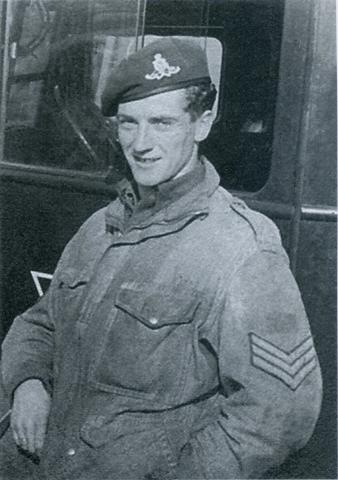
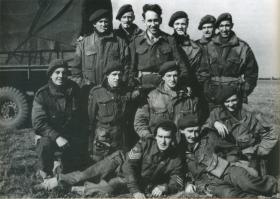
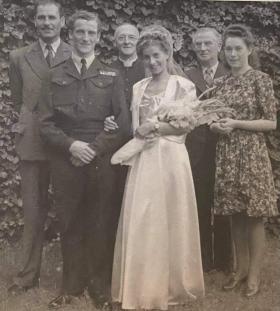
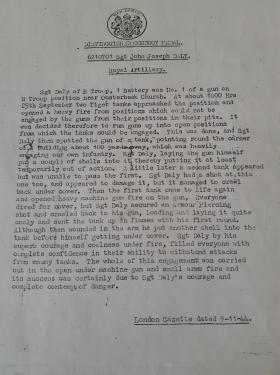
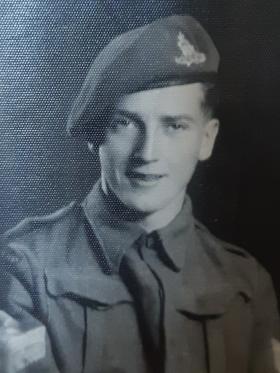
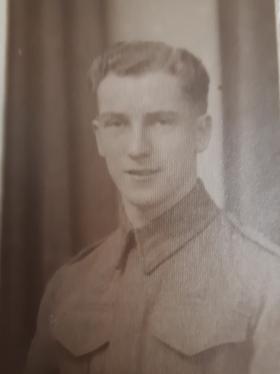
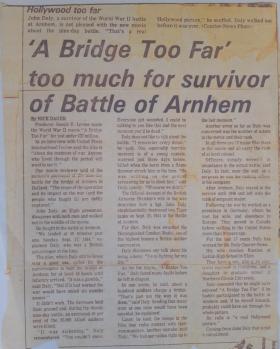
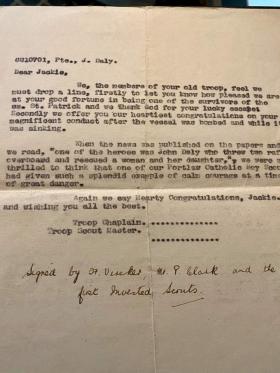
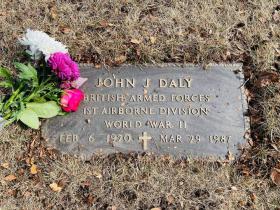
Latest Comments
There are currently no comments for this content.
Add Comment
In order to add comments you must be registered with ParaData.
If you are currently a ParaData member please login.
If you are not currently a ParaData member but wish to get involved please register.